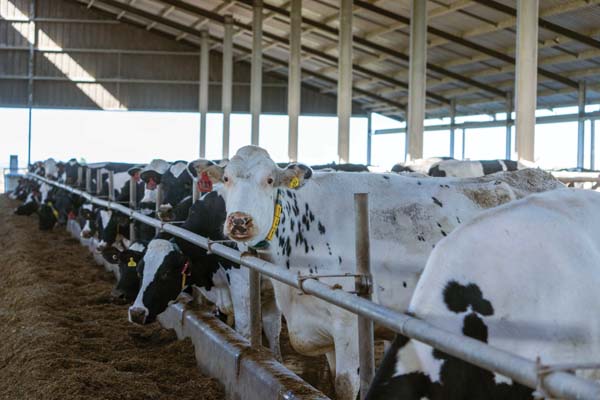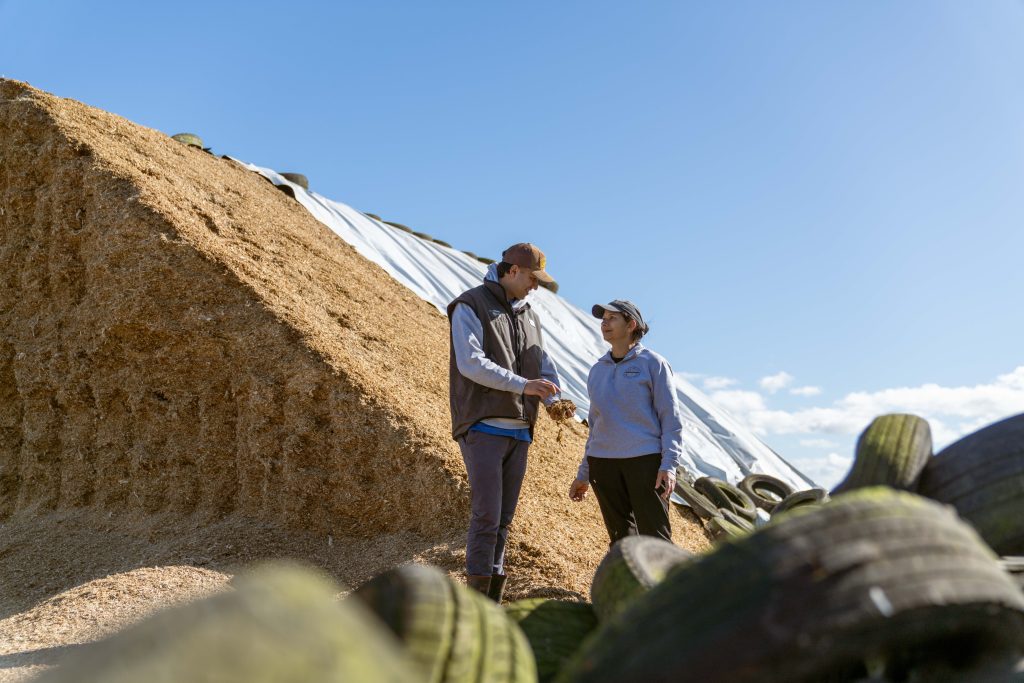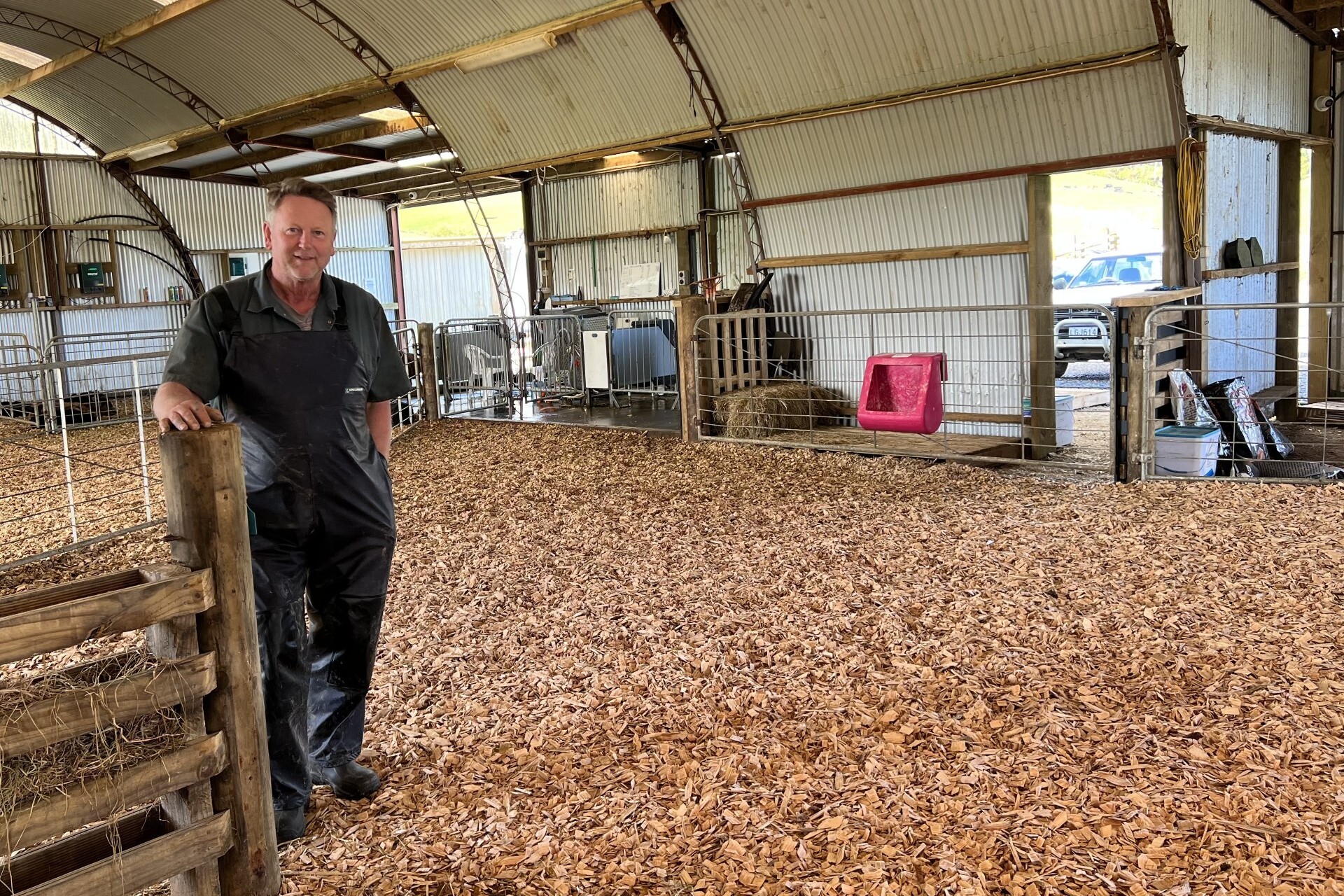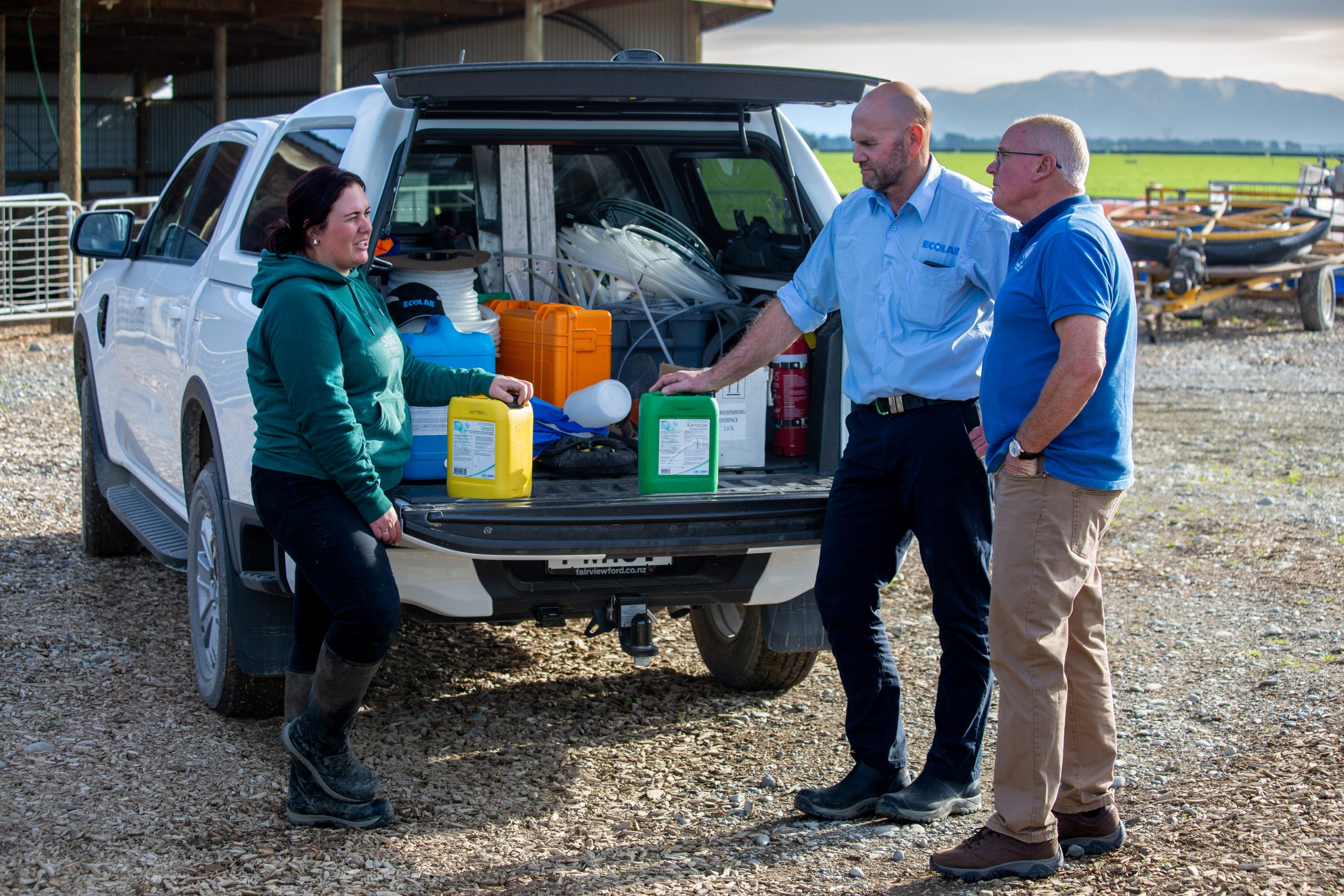Saving peat with a barn
A barn housing 1000 Holstein Friesian cows won the 2023 Waikato Regional Supreme Award at the Ballance Farm Environment Awards, for its commitment to productive genetic gain and precision effluent management. Sheryl Haitana visited the three siblings who are the fifth generation of the Singh family dairy farming in New Zealand.

The 250-metres by 50m barn is the size of 2.5 rugby fields and easily stands out when driving to the Lawwal Holstein stud farm on the peat flats at Whitikahu. Housed underneath the roof are just shy of 1000 Northern American genetic Holstein Freisian cows who spend all winter and summer days in the barn.
It’s a clean, comfy and cool environment with individual padded beds, rubber matting on all walkways, a motorised scratcher in each pen, a motorised scraper constantly pushing effluent out of their way, robots moving the feed up every two hours and it’s just a short walk to the 50-bail rotary to get milked.
“They have everything they could ever want. If they let them outside, they typically run around like excited teenagers for a bit and then quickly head back indoors,” Anjena says.

The barn is in contrast to the traditional New Zealand pastoral model, but for the Singh family the barn has created multiple benefits, from increased production, fewer animal health issues through to ticking environmental boxes.
Winning the Supreme Award at the Waikato Ballance Farm Environment Awards feels like a nod of approval.
“We don’t fit the mould, it’s hard to compare with other farms as we are a bit different, but we are out there everyday, we know what our system can do,” Arjun says.
“It was good to get recognition for what our system does for the environment.
“I think it’s the right direction (having the barn), with the way the seasons are going. If we had 1000 cows out on the peat it would have been a swamp out there this year.
“Peat also fries in the summer so it works well to be growing maize crops during that time to counteract that.”
Siblings Anj, 30, Arjun, 26, and Amreeta, 23, grew up working out on the family farm alongside their mum and dad, Aman and Daljit and their grandparents. The trio are the fifth generation to be dairy farming in the Waikato since their great great grandparents emigrated from India in 1912.
Aman, who built the free-stall barn in 2018, passed away from a heart attack suddenly three years ago and since then Anj, Arjun and Amreeta have stepped up to be directors and will soon be shareholders in the family company and collectively run the business alongside Daljit.
Arjun, 26, who has a agri commerce degree from Massey University, is the operations manager onfarm, overseeing the day-to-day business. Anj, a registered psychologist does all the administration for the business as well as helping onfarm when needed, on top of starting her own business specialising in rural mental health. Amreeta has just finished her master’s degree in interior architecture and is working full time onfarm, also doing the marketing for Lawwal Holstein.
Daljit also still works on the farm as well as their grandad, Karamjit who runs the young stock, which graze on 50 hectares of the farm and come to the feed pad every day.
“It’s a very family run business. We all grew up working on the farm,” Anj says.
“It’s a real privilege to be working with my siblings. We all have different strengths and when we all sit around the table, it all works so well.”
Impressive effluent management
The family discussed entering the Ballance Farm Environment Awards with their farm adviser, Scott Freeman, last year.
Entering the awards took a lot of work, but they all saw the opportunity for a great learning experience to assess how the farm is performing and give them some framework to make decisions on where they want to go with the farm.
Because their system doesn’t fit the typical Kiwi dairy farming operation, it’s hard to compare their performance against other farms, particularly environmental outcomes, so it was beneficial to go through this awards process, Arjun says.
In winning the Supreme award for Waikato, the judges commended their resilience and commitment to honour their legacy, and their passion for progressive dairy systems.
The judges noted the “rigorous attention to effluent management is impressive” and the “pursuit of high-quality genetics has delivered significant productivity gains”.
All effluent from the barn is captured, going through two screw press separators and into a solids bunker and the liquid into the 20 million litre lined pond.
The family recently bought an umbilical effluent injector system which is used to apply the effluent during the year. They apply effluent pre cultivation when they plant their 200ha of maize every spring.
It allows them to inject effluent into the soil bed during cultivation, so the fertiliser is next to the plants, minimising any runoff. They typically apply about 10mm depending on soil test results, Arjun says.
Soil tests are done annually before cultivation to work out a nutrient management plan and to determine application of effluent, although they didn’t use any other fertiliser apart from effluent last year.
They apply 5mm of effluent after cutting the grass silage on the surface using a dribble bar.
They have flow meters in the pond and on the tractor to ensure they are applying the effluent accurately.
The effluent solids are applied to the paddocks before the annual grass seed is planted.
They trialled strip till last year in a few paddocks which didn’t go well as they had issues with machinery. They are hoping to bring more strip tilling practice and less cultivation in the future, Arjun says.
“Minimal tillage is what we are focused on now.”
They have been looking at species to plant on the peat around the drains to help with erosion and are putting a water tester in at four main exit points on the farm to measure outgoing water quality.
They are also looking at other crops that would suit their system. They grow about 70% of the cows’ diet on the farm and are hoping to grow more.
“Harvest was okay this year. We did have a lot of maize blown over so we were about 3-4 tonnes/ha behind our normal 26t DM/ha average.” They trialled faba beans last year which yielded well, but were difficult to harvest as it was too wet.
They are closely watching research on methane inhibitors which would work well in their barn system, Arjun says.
The farm has tested their TMR with Alltech twice, which has shown cows producing 13 and 14g methane/kg DM eaten.
That’s significantly lower than the 21g methane produced per kg DM eaten that Overseer works from. It’s one example of how their system doesn’t always fit the NZ industry figures, he says.
“We are still working around our methane figures and working with Overseer to try and change that fixed number.”

Production gain through high-quality genetics
The family’s legacy of breeding top genetic cows was also recognised by the judges as an environmental win. Those genetics have shown their true value since the cows moved into the barn system, Arjun says.
“We were System 5 before the cows went in the barn and the cows were producing 500kg MS/cow, now they’re producing 750kg MS/cow.
“Bringing feed to the cows works, they aren’t spending any energy walking to the paddocks. So body condition is never an issue, conception rates have improved. We don’t have the metabolic problems like we used to. If we do have any issues we know it’s something we’ve done, a human error.”
“The Holsteins seem to milk well for us and do it for a long time and they look good.”
Since moving the cows into the barn in 2018 they’ve also had no lameness issues and their animal health has improved.
Their average somatic count has halved and now averages 140,000. Mastitis cases are much lower and they are looking to just use teat seal this year instead of any dry cow therapy.One problem is the 650kg cows are getting too big for the farm dairy so they’ll have to address that in the future, Arjun says.
About 30-40% of the cows are doing an 18-month lactation because they are milking too well to be dried off after one lactation.
That suits the split-calving operation well, with a four-week mating in September and eight weeks in autumn.
The top 20-30% producing cows get mated with sexed semen, the bottom 30-40% of the herd goes to beef semen and the middle get conventional Holstein Friesian bulls. Lawwal’s breeding plan is to have a market for every calf that is born, so there are no bobby calves. They also do some embryo work, implanting about 200 embryos annually, some of which are imported from North America.
They genomic test all replacements so they know what calves they want to keep at six weeks old. Selecting the best genetics will help have the most-efficient animals in their herd to suit environmental requirements.
“We are very fussy about what bull goes to which cow. We believe genetics will help us in our farm system going forward,” Arjun says.
“We put a large emphasis on breeding for udders, legs and feet, functional type. We just have to watch with using overseas genetics where farmers are paid for litres, we still are paid for fat and protein.”
They buy semen from Semex, WWS and ST Genetics.
They buy North American Holstein genetics, and also buy overseas beef semen including Hereford and some Speckle Park.
The overseas beef genetics have the fastest growing rates, but still low birthweights, with easy calving, Arjun says.
They have contracts to sell all beef calves at four days old.
The cows calve outside, with the springers able to go in and out of the barn for about two weeks leading up to their due date and then are pushed outside to calve and then get a fresh pen in the barn when they go into the colostrum herd.
Every mob gets a specialised TMR, from the colostrum herd, the springers through to the high-producing milking herd and the younger herd. The cows have had the GEA CowScout collars on for one year now which are helping with conception rates and overall animal health, Arjun says.
People at the heart
The family also won the Bayleys People in Primary Sector Award at the Ballance Farm Environment Awards evening. People are a huge value to their business, Anj says and they were pleased the judges recognised their focus on staff wellbeing and relationships. They employ three milking and barn staff, one full time tractor driver, one allrounder who does tractor driving and maintenance as well as milking.
Farm manager David Maartens has been with the family for 16 years and has even built himself a house on the farm. They aim for an eight hour day for all staff, which is a really important component.
“If they’re working too long it’s not sustainable,” Arjun says.
They treat staff like family and make sure people feel comfortable to bring any issues or ideas to them, Anj says.
“Arjun is also around all day so they can talk to him. We try to be proactive, if we see something happening we deal with it straight away.”
The siblings are looking at ways to grow and improve the business, there are benefits to having the cows off the land, while young stock are still grazed outside – something to look at in the future.
“There are lots of ways to grow our business without getting more land,” Anj says.
Succession talks will be something they develop and grow, they say.
“It’s something on our radar but for now it’s just get in and do the work.”
- To contact Anjena for mental health support visit ruralheightspsychology.com
- To read more or find about any upcoming cow sales visit lawwalholsteins.com
Cow sales give back to community
The Lawwal Holstein ‘The Legacy’ sale in 2022 raised $34,000 for the Rural Support Trust and the Heart Foundation. The family also ran a mini sale raising $10K for Cyclone Gabrielle relief fund.
“We are always thinking about what we can do next to give back, that’s just the way we were brought up,” Anj says.
Anj volunteers for Rural Support Trust as well as starting her own rural specialised psychology business.
“I’ve always wanted to work in rural mental health. It’s really important, and not just to me, all three of us find it important to support mental health in the farming community.”
It’s a specialised area to work in.
“The farming community has a real ‘she’ll be right’ attitude. I think people underestimate how difficult farming can be, how many different hats you have to wear on the same day, or in the same hour.”
KEY FACTS:
Farm Owners: Karamjit, Mindho, Daljit, Anjena, Arjun, and Amreeta Singh
Location: Whitikahu, Waikato
Area: 250ha
Cows: 1000 Holstein Friesians
Production: 750kg MS/cow
TMR: 24kg DM/cow/day, made up of maize silage, grass silage, straw, soya, canola, corn gluten, palm kernel, minerals
Crops grown onfarm: 200ha maize, 1000t grass silage
6-week in calf rate: 73%
Farm working expenses: Feed $2.48/kg MS; Staff $0.65/kg MS; R+M $0.33/kg MS; Animal Health $0.18/kg MS; Free-Stall Barn: $0.09/kg MS; TOTAL $3.73/kg MS





